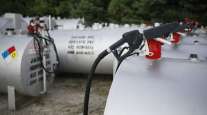Diesel Average Up 1.7¢ to $3.96
This story appears in the Feb. 27 print edition of Transport Topics.
The price of retail diesel rose last week for the fourth consecutive time, edging up 1.7 cents a gallon to $3.96, the U.S. Department of Energy reported.
The pace of the price climb slowed compared with the 8.7-cent spike diesel buyers experienced the previous week.
Still, trucking’s main fuel last week cost on average 38.7 cents a gallon more than it did a year ago, and almost half that increase — nearly 18 cents — has occurred since the start of 2012, DOE said after its Feb. 20 survey of fueling stations.
DOE also said retail gasoline rose for a fourth week, with the average reaching $3.591 a gallon, a 6.8-cent jump over the previous week. Last year at this time, the average price was $3.189 a gallon, a 40-cent difference.
Rising crude prices were blamed for the increases at the pump, oil analysts said, as oil advanced for six consecutive days, closing on Feb. 23 at $107.83 on the New York Mercantile Exchange, the highest level since May 4. Crude has risen 9.9% in the past year.
Analysts attributed the rising cost of oil to Iranian threats to close the Strait of Hormuz, through which almost 20% of the oil traded worldwide flowed in 2011, DOE said.
“Those types of risks, that’s what you’re seeing built into the market right now,” said Chris Barber, at the Wakefield, Mass., office of Energy Security Analysis Inc. “There’s no way, currently, with everything still flowing, that prices should be as high as they are.”
Volatile oil prices and market uncertainty are driving at least one trucking firm away from diesel.
Central Freight Lines, a less-than-truckload carrier, announced Feb. 16 it will purchase 15 trucks powered by compressed natural gas to test at its Houston terminal.
“We’re going to try to abandon petroleum in Texas,” said Don Orr, president of CFL, Waco, Texas, which runs 1,700 trucks out of 65 terminals in 13 states.
“Price is an issue, but it’s more about price stability,” Orr said of the carrier’s decision to seek an alternative to diesel.
Orr said CFL wants to convert its entire Texas operation to natural gas, in part because Houston has a pollution problem and natural gas burns cleaner than diesel.
In Fort Jones, Calif., Tom Menne and his brother, Dan, who haul hay to ranchers and dairy farmers, do not have the option to abandon diesel.
“Our costs have doubled probably in the last 10 years,” Tom Menne said by way of explaining that with rising fuel prices, along with higher insurance and tire costs, they have no capital to invest in new trucks.
The brothers run flatbed trucks at the firm their father, Donald, founded.
Tom Menne said hay hauling is highly competitive so, until two years ago, they operated without fuel surcharges.
“We ended up eating a lot of the increases until . . . our competitors started charging a fuel surcharge and then we started,” Tom Menne said.
The brothers have fuel tanks on-site to buy in bulk to save money with a 7,500-tank they fill twice a month. At 38.7 cents a gallon higher on average nationally, 7,500 gallons means paying $2,900 more than last year for a single fill.
In the face of high fuel prices, three Democrats in the U.S. House of Representatives wrote a letter to President Obama urging him to tap the nation’s Strategic Petroleum Reserve.
“Last year, when you directed the release of 30 million barrels of oil from the SPR — less than 5% of the reserve — in conjunction with the release of an additional 30 million barrels from our international partners, prices declined by 8%,” Reps. Ed Markey of Massachusetts, Peter Welch of Vermont and Rosa DeLauro of Connecticut wrote in the letter.




